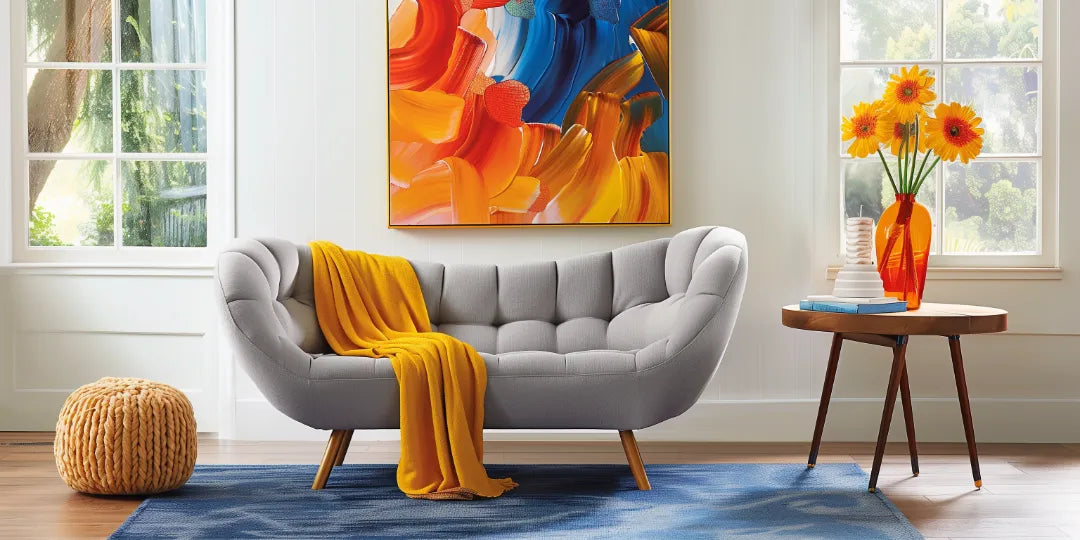
Color Psychology: Choosing Art and Accessories to Match Your Mood
Share
Colors have a profound impact on our emotions and perceptions, influencing everything from our mood to our behavior. By understanding color psychology, you can use art and accessories to create spaces that reflect your desired mood and personal style. Discover how to harness the power of colors in your home or workspace and see how they can transform your environment.
Understanding Color Psychology
Color psychology is the study of how colors affect our emotions and behaviors. Different colors can evoke various feelings and moods, making them a powerful tool in design and art. Here’s a quick overview of some common color associations:
- Red : Associated with energy, passion, and excitement. Red can stimulate and invigorate, making it a great choice for spaces where you want to encourage activity and enthusiasm.
- Blue : Known for its calming and soothing effects, blue promotes relaxation and tranquility. It’s perfect for bedrooms or spaces where you want to unwind.
- Green : Often associated with nature and harmony, green is both calming and refreshing. It’s ideal for creating a balanced and rejuvenating atmosphere.
- Yellow : A color of happiness and optimism, yellow can brighten up a space and evoke feelings of warmth and cheerfulness. It works well in kitchens and living areas.
- Purple : Traditionally linked with luxury and creativity, purple can inspire imagination and introspection. It’s a good choice for creative spaces like studios or offices.
- Orange : A vibrant and energetic color, orange combines the warmth of red and the cheerfulness of yellow. It can stimulate creativity and enthusiasm, making it suitable for social areas.
Choosing Art and Accessories to Match Your Mood
When selecting art and accessories for your space, consider how you want the space to feel and how the colors can help achieve that mood. Here are some tips:
- Define the Purpose of the Space : Consider the primary function of the room. A bedroom might benefit from calming blues or greens, while a home office could use the stimulating effects of yellow or orange.
- Select a Dominant Color : Choose a primary color for the room that reflects the desired mood. Use art and accessories to incorporate this color, creating a cohesive and harmonious environment.
- Add Accents for Balance : Use complementary colors as accents to create visual interest and balance. For example, if your dominant color is blue, you might add pops of orange for contrast.
- Consider Seasonal Changes : Swap out accessories and art to reflect different seasons or moods. Warmer colors in the winter can create coziness, while cooler shades in the summer can promote freshness.
- Personalize Your Space : Ultimately, your space should reflect your personality and preferences. Choose colors that resonate with you and make you feel comfortable and inspired.
Examples of Colorful Art and Accessories
- Abstract Paintings : Incorporate vibrant colors and dynamic shapes to evoke emotion and energy in a room.
- Textiles : Use colorful cushions, throws, and rugs to add texture and warmth while reflecting your chosen palette.
- Wall Art : Select pieces that incorporate your dominant and accent colors to tie the room together.
- Ceramic and Glass Decor : Vases, bowls, and other decor items can add pops of color and artistic flair to any space.
Conclusion
By understanding and applying color psychology, you can create spaces that not only look beautiful but also evoke the right emotions and moods. Whether you're looking to design a calming retreat or a vibrant creative hub, the right combination of colors in your art and accessories can make all the difference. Explore our collection of colorful art and accessories to find pieces that perfectly match your mood and transform your space today.
Harnessing the power of color allows you to express yourself creatively and shape your environment to support your lifestyle and emotional well-being.
